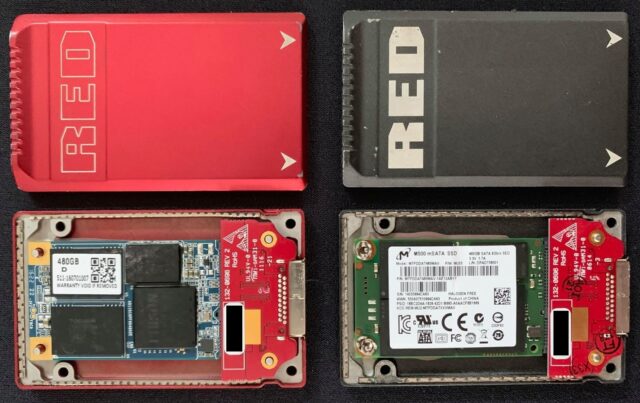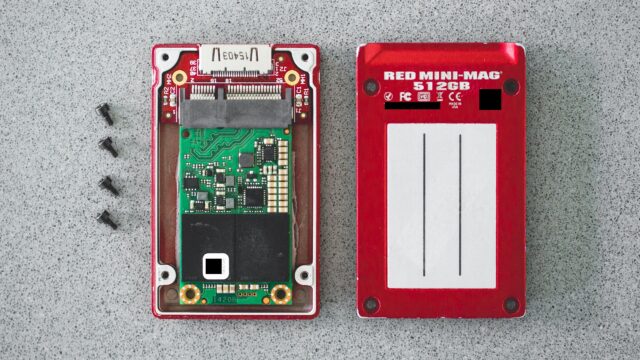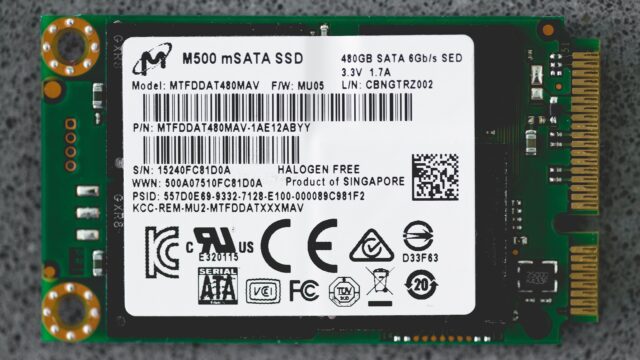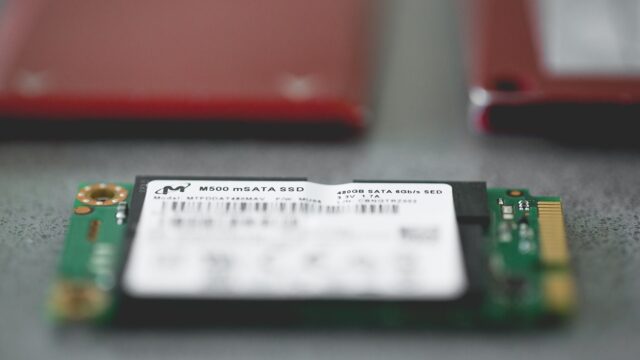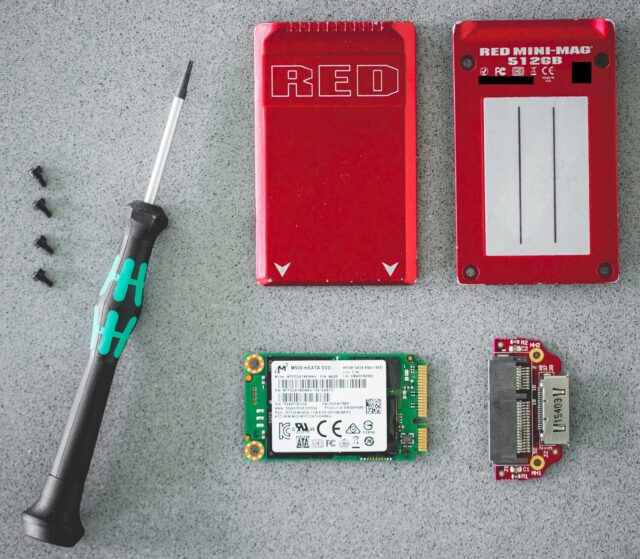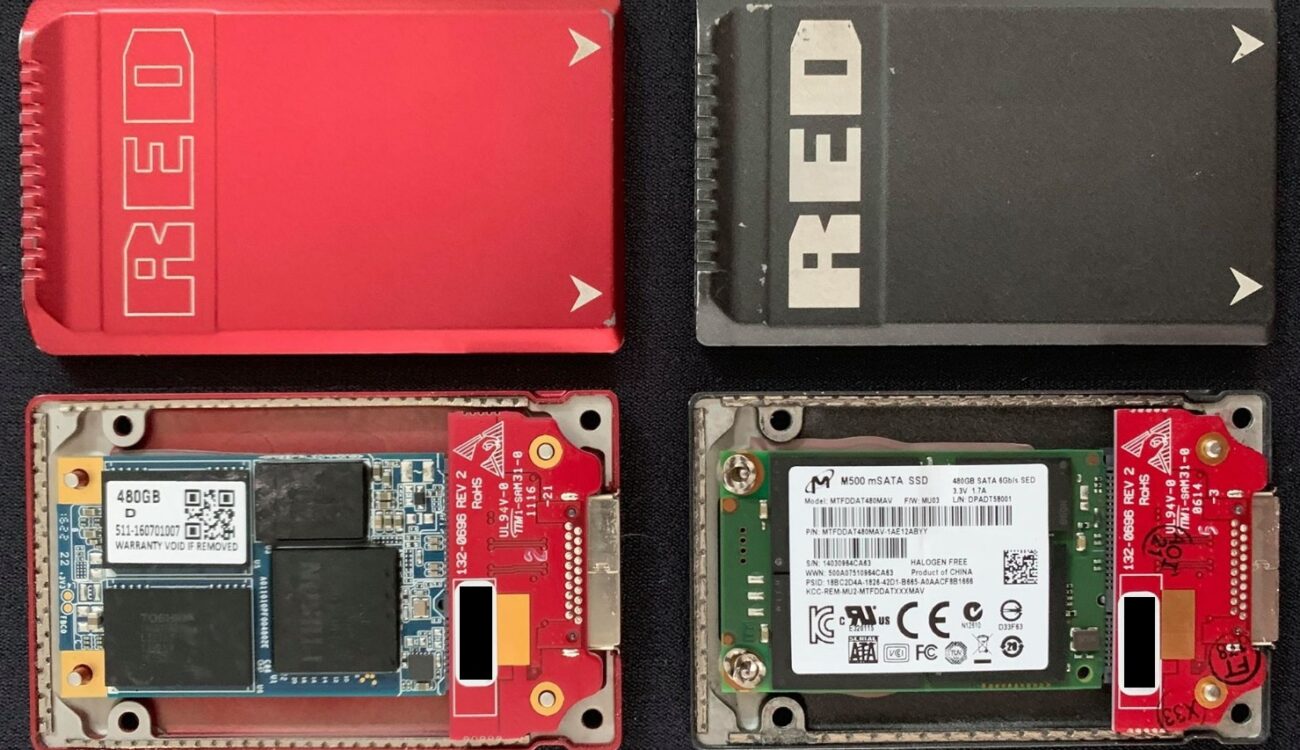
Did you know what kind of hardware rests inside of your RED Mini-Mag? Jinni Tech published a Youtube video of stripping down a RED Mini-Mag and revealing its contents. They claim that RED is only using generic OTS (off-the-shelf) hardware, and they accuse them of lying about the capacity and other attributes of their Mini-Mags. According to Jinni Tech RED is selling their media way over their real price.
We reached out to RED Digital Cinema’s CEO Jarred Land and asked for a statement, and he sent us a lengthy response, which you can read at the bottom of this article. Jarred is explaining the background of the accusations from their point of view, explains the price of RED Mini-Mags and reacts to accusations in the video. Jarred also told us that in reaction to the JinniMag situation, RED will be updating price of their media next week.
RED Mini-Mag Pricing
If you have ever been shooting on RED, you probably thought to yourself that the RED Mini-Mags are quite expensive. RED knows their media is expensive and they explain it with much higher quality and reliability of their mags. RED CEO Jarred Land said they have developed their own IP and invested milions of dollars into testing, certifying, and quality checking each of their RED Mini-Mags. RED cameras are also programmed to only work with original RED Mini-Mags.
Jinni Tech vs. RED
Jinni Tech is a UK-based company which has been selling so-called JinniMags – third party media for RED cameras. The company offers 240GB, 480GB, 960GB and 1TB JinniMags in their online shop, which have the form factor of RED Mini-Mags. They also offer Mini-to-full-size Mag adaptor for use with older RED cameras. Price-wise JinniMags are less then one third of the price of original RED Mini-Mags. For instance 960GB JinniMag retails for £800 (including VAT) and 960GB RED Mini-Mag for £2,300 (excluding VAT).
RED is obviously not very happy about another company manufacturing and selling media for their cameras, as they are loosing profit by not selling more Mini-Mags. Jarred Land has been actively defending original RED media against JINNIMAGS on Reduser for a long time. He claims that Jinni Tech hacked and stole RED’s IP and firmware only to make profit without the R&D.
The Jinni Tech Claim: Consumer SSDs and no RED firmware in RED Mini-Mags
As a response to RED’s claim, a couple of days ago, Jinni Tech uploaded this Youtube video, in which they disassembled a 512GB RED Mini-Mag. They found out that RED is using a simple passthrough adaptor, which costs around $6 US, and a standard off-the-shelf Micron/Crucial SSD (which retails at around $250 US).
RED Mini-Mag “Made in USA” with an SSD from Singapore
The SSD is manufactured by Micron in Singapore and not in USA, yet RED writes “Made in USA” on their case. In this case, it might be enough to assemble the Mini-Mag in the USA in order to be able to use the “Made in USA” seal on it. This is also what Jarred later claimed in reaction to the video.
480GB SSD inside a 512GB RED Mini-Mag
Furthermore, the SSD in the 512GB Mini-Mag only has a 480GB capacity, and it says so on Micron’s label which is still attached to the SSD component inside every RED Mini-Mag. RED actually changed the labeling from 512GB to 480GB in newer models of their mags.
My colleague Nino Leitner reached out to Jarred Land to explain this discrepancy, here’s his reply:
Hey Nino, that whole 512gb/480gb thing is a general hard drive industry thing. Almost everyone originally sold and advertised SSDs/Hard drives/Memory Cards with the total amount of space, and then gradually everyone shifted to “usable” space after formatting and adding over provisioning, specially with SSD’s to prevent overwear. a 480gb card that has provisioning is still indeed at it’s base a 512gb card at chip level.
Kingston explains this here
Does RED use proprietary algorithms to write on Mini-Mags or not?
As seen in the disassembly video, the serial number of the SSD shows that it is only a standard off-the-shelf product with no proprietary RED software. RED, however, claims they ARE using their proprietary algorithms to write to the RED Mini-Mags, but they are encoded in their cameras (more on this further down in Jarred Land’s reply).
In order for JinniMags to work, the firmware needs to be updated to “make the RED camera think those are original RED mini mags”. That is also explained in the video. It looks like Jinni Tech is planning to publish more videos on this topic in the future.
Trying to verify some of the video’s claims
We reached out to some colleagues and friends who own RED Mini-Mags with 512GB capacity and asked them to disassemble them for us to check what’s inside, simply to verify what’s claimed in Jinni Tech’s video. Hours later, we received a number photos from two filmmakers who disassembled their 512GB RED Mini-Mags. There were indeed 480GB SSDs in both of them. (These are the photos in this article). Both filmmakers who provided the photos wish to remain anonymous, but cinema5D knows their identity. Upon request we also blurred the serial numbers on the outside casing of their RED Mini-Mags.
We reached out directly to RED Digital Cinema’s CEO Jarred Land to get his official response to the subject. Here is his reply in full (unedited) length:
RED CEO Jarred Land’s email reply to cinema5D:
Nino and team,
Thank you for reaching out to RED and inviting us to respond to the allegations of Bruce Royce, the owner of JinniMag.
This video was made by Bruce, who admits that he reverse engineered the RED Mini-Mag. He did not come to discuss with RED through our third party approval process, but instead he started developing his own product to spoof the RED Mini-Mag. In the summer of 2016, he created an account on RED’s website and downloaded the RED Firmware for development purposes. In August 2016, a user named RichardR (Bruce Richard Royce admitted in his deposition that he sometimes uses his middle name “Richard” to fool people into believing there were more employees at JinniMag) was on message boards asking for help with false pretenses to learn how to do exactly what was demonstrated in the YouTube video you sent over.
Mr. Royce then announced the release of his JinniMag device in July 2017. Several people made comments on RedUser, and I responded expressing my personal opinion. He was not pleased with my response, and comments made by other third parties. Mr. Royce filed a lawsuit against RED and myself first. After that, we sued them for patent infringement, trademark infringement and a host of other things here in California. During the process we had an expert that testified that they infringe. He had no response to that. And just when we were a couple months from trial, his last group of attorneys quit on him. This was the 3rd group of attorneys to quit on him.
So, we looked at the fact Mr. Royce has no money to pay us when we win at trial, and the fact we would have to incur 10x more in legal fees than we could obtain in damages, we decided to dismiss the case “without prejudice.” This means that RED can sue him again if he resumes building infringing product.
The judge’s notes were conveniently cropped and left out of Jinni’s statement on the matter, I have attached the Judges order in full if you want to see what the Court actually noted.
Next, let me respond to the specific allegations in his video.
Jinni’s argument that RED has not developed its own IP and firmware is preposterous. RED built and ecosystem of IP around its REDCODE technology. This ranges from the sensors to cameras to software, and includes the recording media. All aspects of the RECODE ecosystem are patented.
Jinni next takes issue with the fact that I stated that our cameras write differently to our Mini-Mags than normal SSDs are used to. This is 100% true. Not all SSD can handle the REDCODE workflow. We have tested over 100 SSD and media components over the years, and most do not have the sustained performance to pass our criteria. For example, some Micron SSDs meet our benchmark and others do not. As a prime example, the first products that JinniMag put out were tested by RED and found to fail. When we opened it up it was using an SSD we knew to cause failures and when we tested the Jinnimag card, it indeed did fail after filling past 60% of capacity. We would never use such media because if media fails on a shoot, our users all suffer. That’s why we have high testing standards.
There is also a bizarre accusation that people think we actually claimed to make the memory chips ourselves.. which never has been claimed. RED Mini-Mag housings are easily opened and as many have done in the past (mostly out of curiosity) they have opened them to peek inside. We leave the manufacture name and model number on the SSD’s in plain sight because we are not trying to hide anything.
But since the Jinnimag card was spoofed into thinking it was a RED card, and even worse the units we received had not just different media but errors in the spoof code, this could have disastrous impacts to our customers. Even well after the shoot was over and problematic footage was copied off the cards onto the editors hard drives with no indication that this came from an Jinnimag card. If there were errors found it would be impossible to troubleshoot and of course we would unfairly shoulder the liability, and even worse the customer would be stuck in the middle. You can understand how serious of an issue this could be.
Yes, we do have significantly less card errors than other companies that allow the use of generic media. Not all media is created equal. That does not guarantee no errors ever. But, we have support in place to assist if there are card errors.
RED does not market and advertise the Mini-Mags as Made in the USA. Mr. Royce is confused in his understanding of legal requirements when RED designates a product as “Made in the USA” for country of origin purposes. RED placed this country of origin designation on its products. It is legally required to do so. That indicates the place of transformation into the final product. This does not mean or require that every component have been physically made in the USA, but tells a customer where the substantial transformation to arrive at the final product occurs.
As for the media designation, RED previously had 512GB Mini-Mags and then converted to 480GB drives. The 512GB reference had always been a industry-conforming reference to the larger drive space, some of which was partitioned for other functions and the usable space has been lower. But, the cameras themselves do not misrepresent what the media are. This is another area where Mr. Royce is incorrect. Our media incorporate unique identifier strings that verify the products as approved media and tell the camera how to record to them. If media is not approved/authenticated, then the camera reduces the record speed to protect the media. Mr. Royce found that his JinniMags would not work in the RED cameras until he found and copied this identifying string within the RED Mini-Mags. When he copied and applied that to his devices, then his devices spoofed RED Mini-Mags and told the camera that they were “RED Mini-Mag” when they were not in fact so. You will see that even in his video, he takes generic media and plugs it into the RED Mini-Mag adaptor, which adaptor tells the camera that the SSD is a RED Mini-Mag.
So, in the end, what we have said is true. RED does not use generic media – we do not use non-branded, lower quality media. We benchmark and qualify all media to ensure they can handle the REDCODE process. Like any product, not all the parts are sourced in the United States, but for country of origin purposes, the proper designation for RED Mini-Mag is USA. RED has its own firmware to write to the media, and the media has its own unique identifiers to authenticate the writing from the camera firmware. And, RED does have a patent that covers the encoding and decoding of REDCODE to this media. The camera verifies the authenticity of the capacity and performance of media to ensure that users are using media that works with this workflow. RED is not opposed to 3rd party development of media. Jinni never went through that process. But, other parties can if they can verify the performance benchmarks that RED has set for its own media. Third party participation has always been part of the RED DNA.
Now onto the pricing which I think is the part that our customers care the most about. We’ve always acknowledged that the RED Mini-Mags are expensive. We’ve spent millions on R&D around the media recording, including all the testing and support, salaries and rent and power and all other business costs as well with all the tooling, jigs, etc, get split up and added to the raw cost of goods. Just to give you a broad stroke of the associated costs above just the raw parts of the RED Mini-Mag, here is an example of the process.. all parts of this process cost money to complete, and that money needs to be added to the BOM cost ( raw cost of parts.)
- product specifications;
- mechanical and hardware engineering design;
- firmware engineering;
- thermal engineering;
- mechanical engineering;
- connector design;
- acquiring and testing components;
- acquiring test equipment;
- engineering testing;
- performance testing and benchmarking;
- test analysis;
- establishment of performance benchmarks;
- software programming;
- quality control testing;
- purchase and build commercial units;
- test each manufactured unit to confirm performance prior to sale.
After design, testing and verification, to manufacture the units, RED needs to make or purchase the various components and assemble the units.
Some components of the final Mini-Mag product are custom made by RED. Other components are purchased from third parties. Final assembly is done by RED at its headquarters. After assembly, each RED Mini-Mag is tested and validated for its memory read/write prior to shipment. The cost of the tools, as well as the cost of tooling for the manufacture of each Mini-Mag, represents additional incurred costs. Other costs include the costs of marketing and sales overhead associated with the products. These are quantified numbers, and Mr. Royce is just wrong in his statements and assumptions.
RED also spends hours each day at no charge doing media recovery for customers – at no charge.
That is all rolled into the price of the purchase. That’s why our mags are the price that they are.
The silver lining ( for our customers ) is that the amortized costs of development are eventually paid down and lower prices are reflected, we have done this a few times already. And even though our next price adjustment wasn’t due till the end of the year, in light of all this drama we are going to adjust our prices ahead of schedule next week.
Who’s right, and what’s your verdict?
Naturally, there is also a lively discussion about the video and RED mini mags on Reduser. Some other users also disassembled their RED mags to confirm it is the same 480GB Micron SSD as in the video. The thread is getting very long and Jarred Land himself also posted few answers there.
The story continues here in our new article: RED MINI-MAG Prices Drop & Jinni Tech’s Second Video
What do you think of this video and the case? Do you use RED cameras? What is your experience with RED mini mags reliability and have you ever tried JinniMags? Let us know in the comments below.
